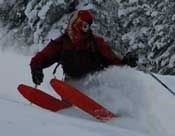To keep things simple: I am firstly wanting to consider how a ski performs on piste. (Clearly in deep poweder different factors come to dominate), which is 99% of my skiing.
I understand the effect of inclination of the ski, on decreasing the turn radius. Also I understand why a ski standardly starts with positive camber (so the tips and tails will essentially always be touching the slope, and the ski pressed into reverse camber when the ski is weighted).
So the million dollar question: what shape should the side cut be; if you want the arc that the ski makes in the snow to be circular, i.e. so you can set up perfect carved arcs ?
I'm not convinced by the blithe way that people talk about planes cutting cones and hence giving you conic sections; i.e. parabolas, maybe elipses etc..., as yes we have a plane (i.e. the piste) cutting --or intersecting-- an inclined something: but once the ski is in reverse camber, why should the shape of the edge of a ski be as if part of a cylinder, and indeed if it was, that would generate a conic section, not the other way round...?
Is it the case that actually the ski would always need to have had a different shape in design depending on the angle on inclination , and therefor any design shape is a compromise short of having a dynamically changeable side cut radius ski?
I should be able to think this through (I'll admit to having a maths degree.. a long time ago but heh I never was any good at geometry) but I am being lazy; anyway it's a physics/ engineering problem isn't it ?
I feel this should have something to do with differential geometry, gauusian curves etc....
Any geometrists out there ?
I know everyone always assumes curves must be conic sections, but there are many smooth curves that kind of look like that but aren't e.g. cateneries... etc...
so some technical terms to perhaps get the physics juices flowing (or indeed perhaps for search engines to find !)
conic sections, geodesics, Klothoids, parabolas, elipses, segments of circles, strakes, gaussian curvature, glissette roulette, hypocycloid, catacaustic, cardiod, etc etc.... when you start looking there are so many smart smooth curves that have ben defined, and examined, which should I make my skis follow?
I'm sure that the conventional pressure/ flex observation effecting the geometry makes life more awkward still; as the ski of course won't bend uniformly, but I think there must be an argument for the pressure distribution changing dynamically so the ski bends into whatever geometry guarantees touching the surfcae all along its length. If this is so, then getting the geometry right at design will even out the actual pressure "anomolies" along the edge of the ski in use. Also, this may explain why the geometries mentioned in the tech article, turn out to not acually be too important: it all goes bananary and sorts itself out however it was made: only the gross side cut really effects things. Similarly the reson why flex profiles seem so variable and there is no consensus: apart from gross stiffness issues as long as the ski can bend smoothly; and as a skier you will be able to bend it in use, the rest just doesn't matter: hence there is no real consensus between mass manufacturers on shape, or flex distribution: only on "stiff/soft" and "short radius/ long radius" geometry.
Any views guys and girls ?
Jonathan





